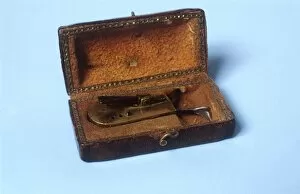Scarificators Collection
"Exploring the Intriguing World of Scarificators: A Glimpse into 19th Century Medical Practices" Step back in time and discover the fascinating world of scarificators
All Professionally Made to Order for Quick Shipping
"Exploring the Intriguing World of Scarificators: A Glimpse into 19th Century Medical Practices" Step back in time and discover the fascinating world of scarificators, a medical tool that played a significant role in 19th-century healthcare. These peculiar devices, such as cupping sets and mechanical scarificators, were used to perform bloodletting procedures for various ailments. One intriguing artifact from this era is the Cupping set from the 19th century (C017 / 3573). This particular set showcases the meticulous craftsmanship and attention to detail prevalent during that time. Its elegant design reflects both functionality and aesthetic appeal. Another remarkable find is the Mechanical scarificator from the same period (C017 / 3563). This innovative device revolutionized bloodletting by automating incisions with precision. It allowed physicians to swiftly create multiple cuts on patients' skin, facilitating controlled bleeding. The collection also includes several other cupping sets like C017 / 3552, C017 / 3575, C017 /3589, and C017/3590. Each set exhibits unique characteristics while serving a common purpose – promoting healing through suction-induced blood flow redirection. Mechanical scarificators like those found in C017 /3564 and circa1780-1900 (C017/3562) demonstrate how technology advanced over time to enhance medical practices. These instruments feature intricate mechanisms designed for swift blade deployment while ensuring patient safety. A standout piece among these historical artifacts is the six-blade scarificator from the early twentieth century (C017/3571). With its increased cutting efficiency due to additional blades, it represents an evolution in scarification techniques aimed at achieving more effective results. Delving further into history reveals Weisss Scarificator circa1820—a testament to individual inventiveness within this field. Its unique design showcases how different practitioners sought innovative solutions to improve patient care.

















